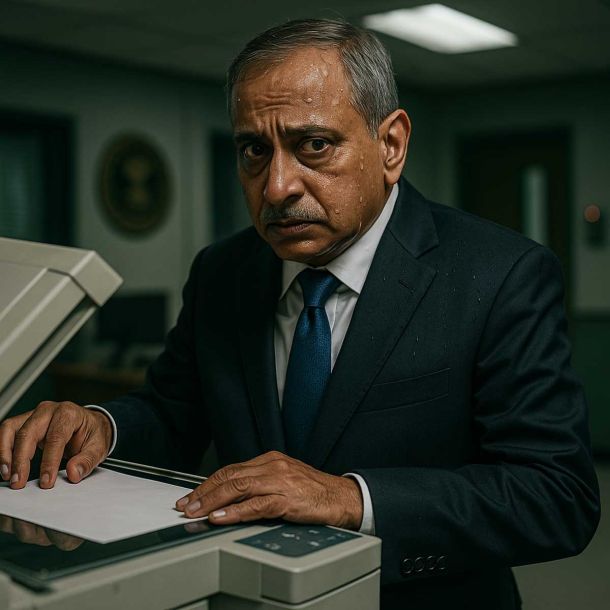More Coverage
Twitter Coverage
Satyaagrah
Written on
Satyaagrah
Written on
Satyaagrah
Written on
Satyaagrah
Written on
Satyaagrah
Written on
Join Satyaagrah Social Media
21-yr-old girl Bina Das shot Bengal Governor in her convocation programme at Calcutta University, got Padma Shri but died in penury
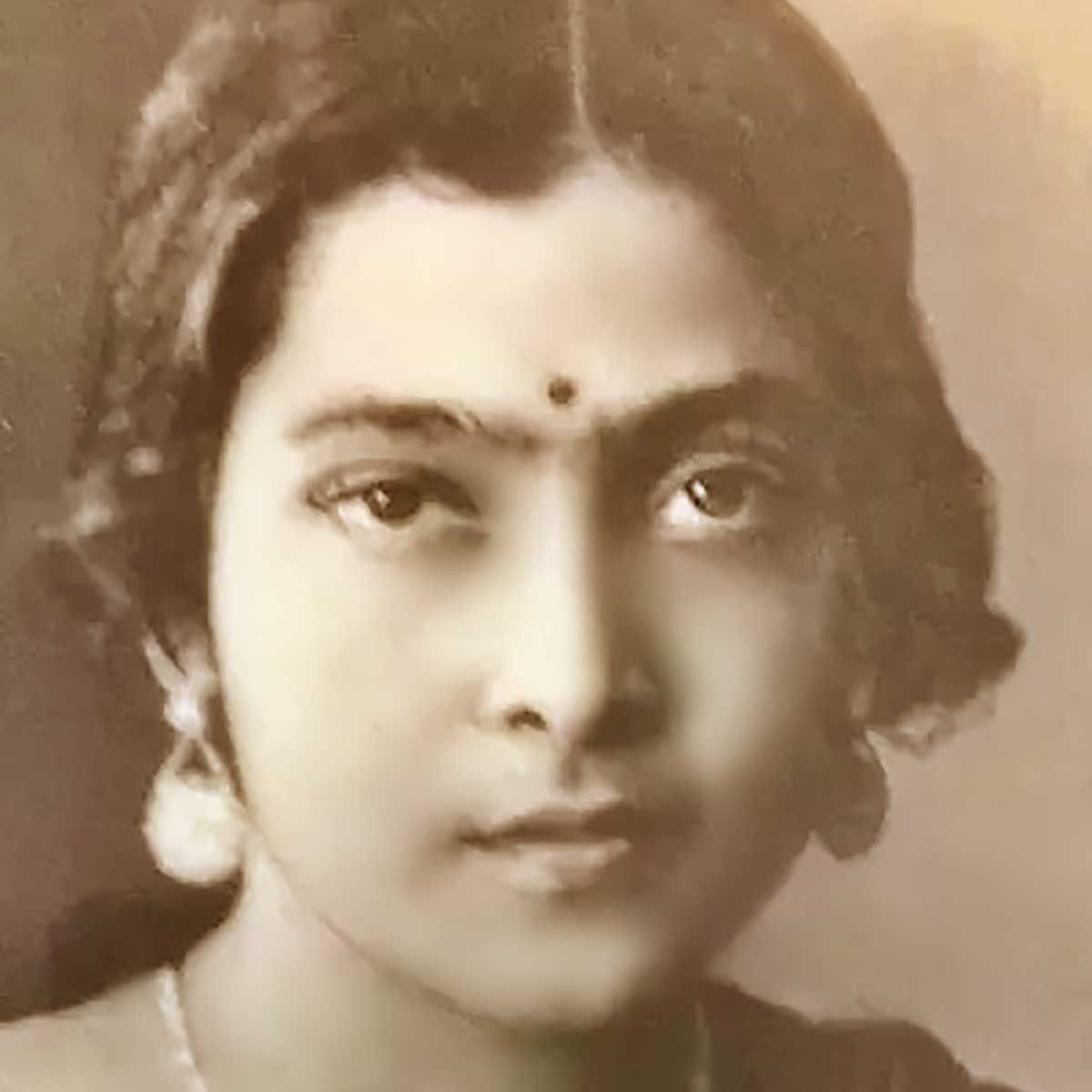
The fight for Indian Independence has generally been projected as being male dominated, with focus on well known male leaders purportedly fighting for India’s freedom. However, that has not always been the case, and in some recent studies it has been clearly seen that how women once inspired by various revolutionary leaders played active roles on their own, and how many of them were direct participants in the nationalistic revolutionary activities that took place in Bengal, Punjab, and Maharashtra.
Besides being directly involved, women also provided a large motivational support system by helping to hide, and carrying secret messages and weapons for the men fighting the war. Unfortunately for us, we will never know their names or see them in the lists of those who fought for our freedom. More often than not these women came from poor or the middle class segment of the society, and the help they provided arose from their love for the nation and did not wait for any kind of social approval. Like the direct participants these supporting women also remain in oblivion with almost zero acknowledgement.
With little idea of the growing women participation among most of the nationalist leaders of those times, Gandhi himself gave a confusing perspective of what a women’s role should be in this fight for freedom. His statement that women should be both active and passive was almost meaningless, and while claiming men and women to be both equal, he also preferred women as mistress of the home and men as wage earners; thus, indirectly appealing to the women to be self sacrificing and adopt peaceful means of waging the war, where the woman’s attention and priority would always be her family before the nation.
Thus, in the ‘Gandhian freedom fight’ women would always remain in the background, focus on family and forging kinship bonds, and remain within patriarchal lines. However, luckily for India many women from Bengal, Punjab, and Maharashtra did not adhere to such logic, and took both direct and indirect part in the fight. This article will take a brief look at three such women from Bengal who had taken direct part in India’s fight for freedom.
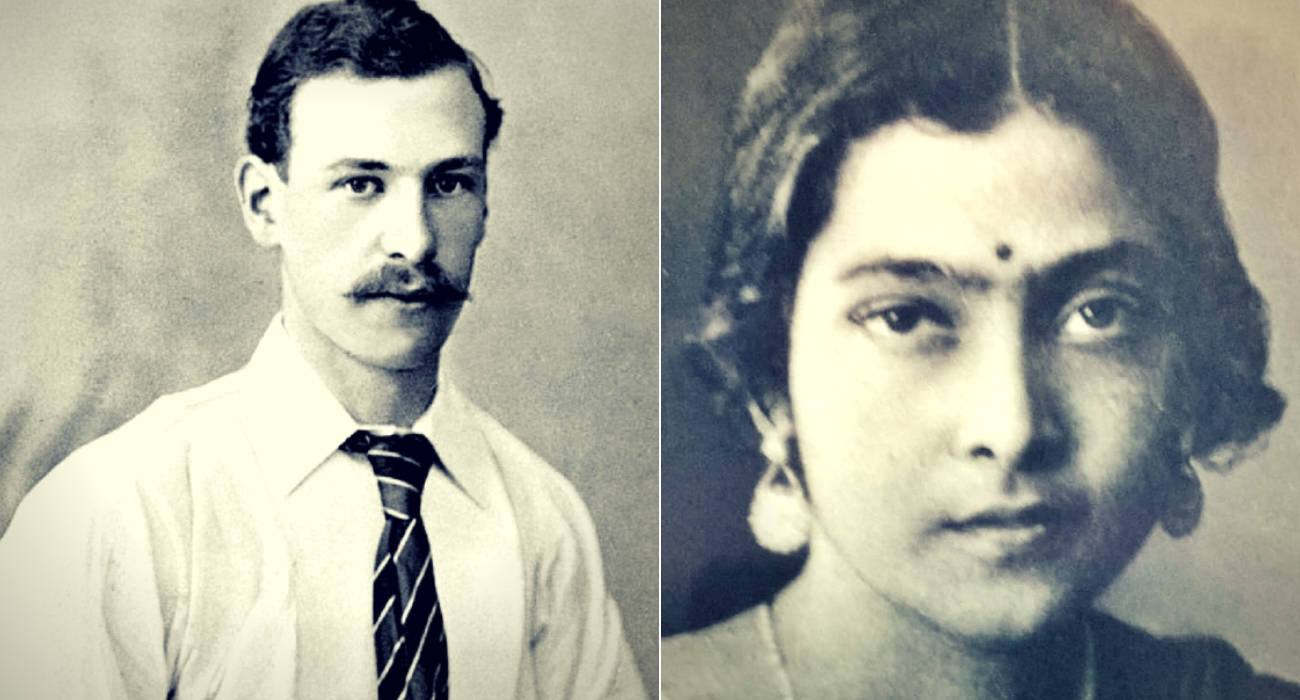 February 6, 1932, It was the convocation ceremony of Calcutta University. Bina Das opened fire at Stanley Jackson |
Bina Das, she was just 21. But she still opened fire on Bengal Governor Stanley Jackson in the convocation hall at Calcutta University. She was supposed to get her graduation degree the same day in 1932, at the same venue. Das served nine years of hard labour for her act which stemmed from a deep desire to see her homeland free from British occupation. But then not many know of Bina Das, one of the many women who were at the forefront of the freedom movement in Bengal.
Das’ parents, Beni Madhab Das and Sarala Devi, both of whom were social workers and educationists, were deeply involved with the Brahmo Samaj. The duo believed in giving their children, especially their daughters, freedom, education and instilling a quest for learning. Uncommon traits in the early 1900s. Das’ mother Sarala Devi also ran a women’s hostel named Punya Ashram in Calcutta that doubled as storage space for bombs and weapons the revolutionaries used. Several occupants of this hostel were revolutionaries themselves, belonging to various underground groups.
Her parents’ involvement in the freedom struggle was indirect and they focused on the upliftment of women and women’s rights in Bengal. But Beni Madhab Das, as a professor, served to inspire many of his students for the cause of India’s freedom, the most notable being Subhas Chandra Bose.
In her own memoir, translated from Bengali by Dhira Dhar, Das mentions how deeply “Subhas babu” was inspired by her father and was a regular visitor to her parents’ home. Das’ first meeting with Bose stands out in the memoir. She remembers her mother saying: “Subhas, my daughter is a great admirer of yours.” Bose’s political beliefs appealed to a young Das, serving to further her anti-British stance.
In her memoir, Das “vividly” recalls an incident that occured when she was still a school student. “One day we heard… that the British Viceroy’s wife was coming to visit our school. The day before that we were called from class to rehearse the programme of welcome,” wrote Das. “We would have to carry baskets of flowers and scatter the flowers at her feet as she entered the premises. I was revolted by the idea and walked out of the rehearsal. The plan was so insulting. I sat quietly in the corner of the classroom with tears in my eyes. Two other girls also walked out and joined me.”
According to Das’ own writings, this incident held more significance than may appear. “Much perturbed, we took a vow that we would sacrifice our lives for the freedom of the motherland. Later in life I often remembered this childish vow, and in moments of weakness it gave me strength and hardened my resolve.”
Bose continued to play the role of a mentor in Das’ life, especially when she joined Bethune College, under Calcutta University as a college student. The college library and books that urged theories of revolution and freedom further encouraged Das’ beliefs and hopes for an independent India. Das, along with her group of fellow students, organised their first student protests against the Simon Commission that arrived in 1928 and faced threats from the college administration and the English principal if they did not apologise.
In what may be called Das’ first taste of victory against British oppression, the students’ protests against the Simon Commission and refusal to submit to the college’s demands, led to the “overbearing Englishwoman” resigning from service and leaving the institution.
This revolt laid the foundations of what came to be known as the Chhatri Sangha, a women student society that was semi-revolutionary in its activities. Das’ sister Kalyani, was the secretary of this organisation. Like other revolutionary groups that came up across Bengal during the time, the members of the Chhatri Sangha were taught basic self-defence including lathi lekha, where the women were taught to use batons. This student group also served to recruit other members and was helmed by noted revolutionaries like Dinesh Majumdar.
The full extent of Bose’ role as a mentor and individual who deeply inspired Das can only be understood through readings of her memoir. Their conversations and meetings when Das was a college student involved reflection of their beliefs and discussions between the mentor and mentee on the future of their beloved motherland. “How do you think our country will get freedom? Through violence or non-violence?” asked the student. The teacher replied: “You must want something madly before you can achieve it. Our nation must want freedom passionately. Then the question of violence or non-violence will not be important.”
As the struggle for freedom adopted secrecy and began operation underground, Das along with her contemporaries, women like Suhasini Ganguly, sisters Shanti and Neena Dasgupta, found themselves driven by slogans like, “karenge ya marenge”; we will do or die, one that finds specific mention in her memoir. “The mantra….inspired the boys and girls of Bengal long before it became a slogan in 1942.”
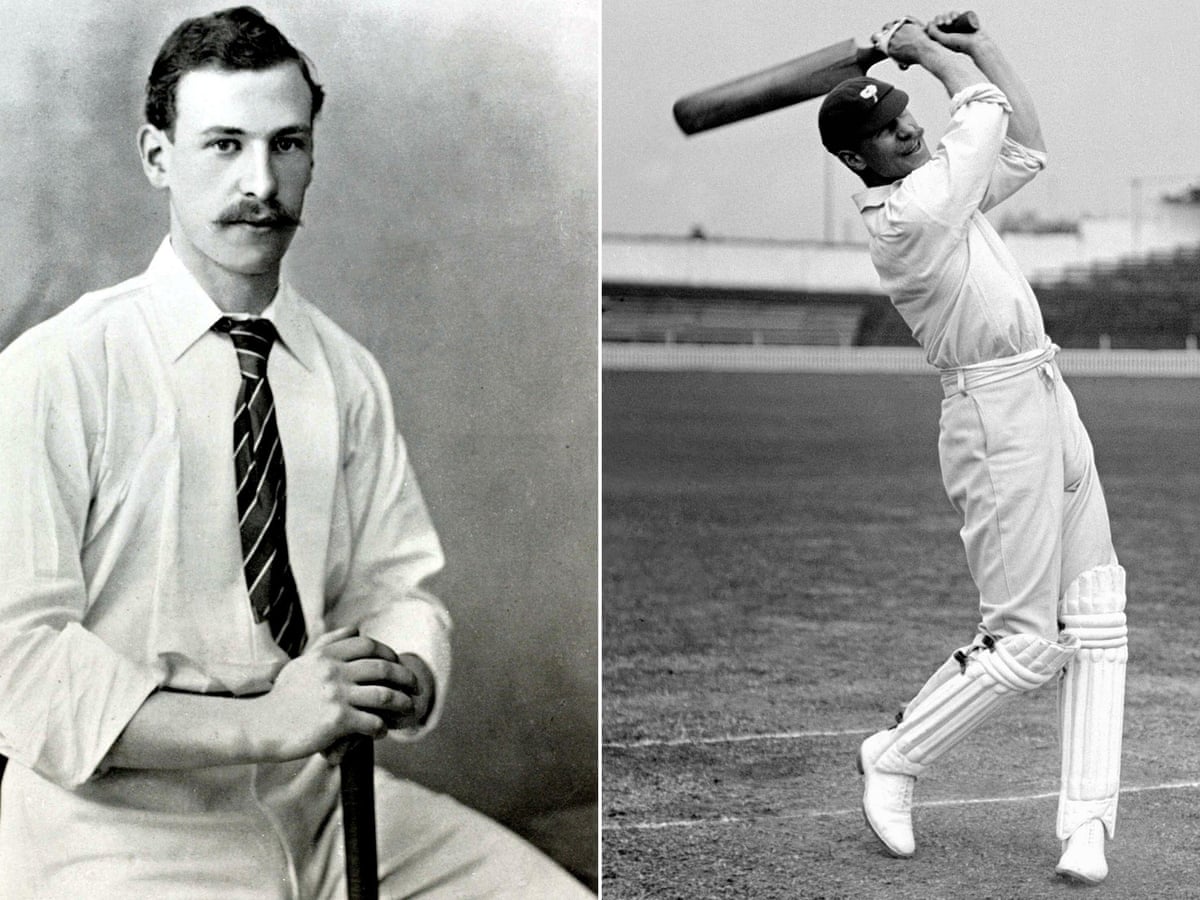 Governor and the Chancellor, Stanley Jackson |
In the spring of 1932, Das learned that the Governor of Bengal, Stanley Jackson, would attend the convocation ceremony at Calcutta University. Explaining her motivations in her memoir, Das states quite simply, that it “would be a great occasion to register (her) protest against the empire”. Das approached her friend Kamala Dasgupta, a revolutionary associated with the Jugantar, another revolutionary group, for weapons. After a volley of questions and answers, including attempts to enlighten Das of the serious consequences of opening fire on the governor, Dasgupta agreed to supply the weapons Das needed to carry out her plans.
At the convocation, Bina Das fired five shots at Jackson at close range, but was tackled and disarmed by Hassan Suhrawardy, the first Muslim Vice-Chancellor of Calcutta University. Das was imprisoned and the British, having been so impressed by Suhrawardy’s noble deed, awarded him a knighthood for the trouble.
Newspaper back in England, devoted columns to the incident with headlines like “Calcutta Outrage; Stanley Jackson’s Narrow Escape” in the Glasgow Herald.
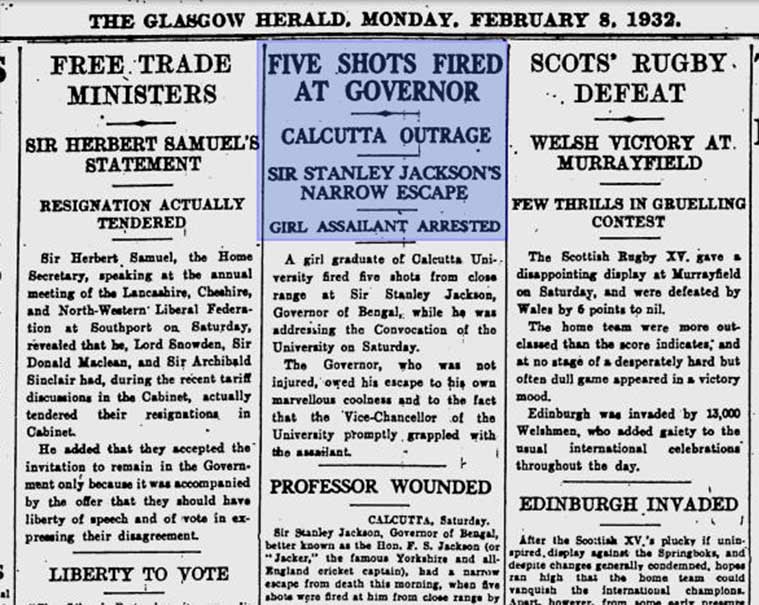 The February 8 1932 edition of the Glasgow Herald devoted an entire newspaper length column to Bina Das opening fire on Stanley Jackson at Calcutta University |
Feminist author Radha Kumar, in her book ‘The History of Doing’, writes that Dasgupta collected funds from other group members and engaged a male comarade to purchase the gun. In her memoir, Das explains the anxiety and hesitations she felt before the event that changed her life and the fears her parents had when she told them of her plans to open fire on the governor. Freedom fighters themselves who had instilled these very values in her from a young age, they understood her desire to devote her life to the cause of the freedom of the country. “They knew their daughter would do anything for the country.”
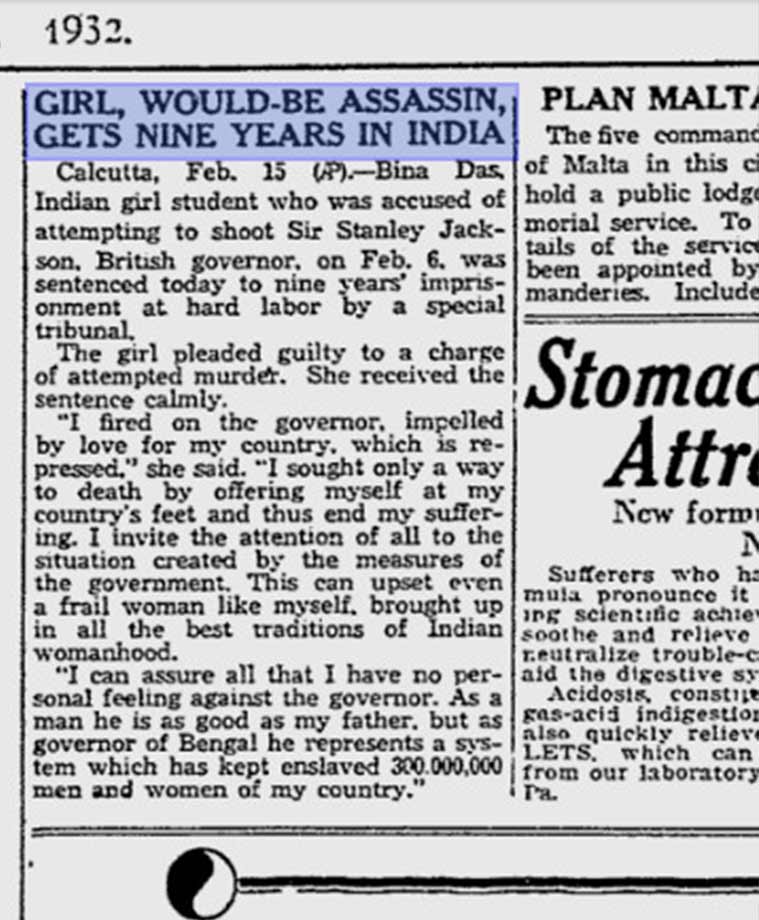 The February 15 1932 edition included a small copy on Stanley Jackson surviving the gunfire at Calcutta University |
After Das’ release from prison, she returned to a world she felt was different from one that she had been made to leave nearly a decade ago. She met her mentor, Bose, for the last time, only to never see him again.
In the early 1940s, her work for the freedom movement once again led to her imprisonment in Presidency jail, till she was released in 1945. Continuing her fight against the British, Das witnessed more despair and bloodshed in the run-up to independence. In 1947, she married a fellow revolutionary, Jatish Chandra Bhaumik, a member of the Jugantar group.
Not much is known about Das’s life after India attained independence. In 1960, the Government of India awarded her the Padma Shri for her contributions in social work. According to some reports, she died in destitution and poverty in December 1986, her body having been recovered from a ditch in Rishikesh, decomposed so severely that it took authorities weeks to identify.
Due to her revolutionary activities, the British authorities of Calcutta University had denied Bina Das her graduation degree, in a futile attempt to penalise and pressure her for her anti-British stance. About 81 years later, in 2012, the University of Calcutta posthumously awarded Das her pending Bachelor of Arts degree with second class Honours in English for the year 1931.
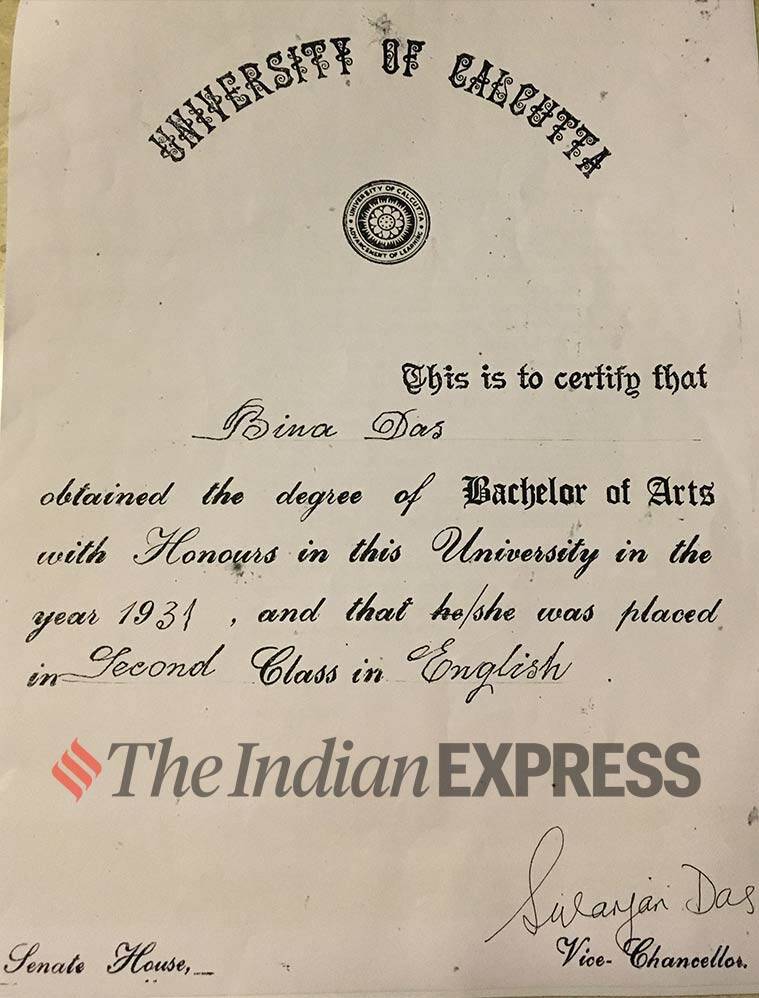 In 2012, Calcutta University posthumously awarded Bina Das her pending Bachelor of Arts degree with second class Honours in English for the year 1931, that the British administrative authorities had withheld from her. (Express Photo by Neha Banka) |
“A second class Honours degree is very prestigious because marks were allotted differently during that time,” said Dr Soumitra Sarkar, Librarian of Calcutta University, who oversees university archives told indianexpress.com. “Many freedom fighters graduated with similar marks from the university, but that is not a reflection of their academic abilities because the system was different then.”
The various pressures that Das and her contemporaries were subjected to by the British failed to dissuade them in their cause and the withholding of her academic degree would possibly not have been of much concern to a woman who had dedicated her life to a nation and people who forgot her towards the end of her life. But her hopes for her nation are clear in the opening sentences of her memoir.
“The fifteenth of August is drawing near. Though our minds are filled with despair and heavy with despondency, though dark shades of doubt loom large, the thought that we are becoming free at last….flashes like lightning through our thrilled souls. We have attained freedom. The British are leaving this country forever.”
“Maybe, today we are unable to appreciate the significance of this event; but, in the course of time…true realisation will dawn upon those, our future progeny, who will build a golden future for our nation on the foundation of this hard-earned freedom.”
References:
The Better India
Zubaan Books
World Cat
India Of The Past
chaseyoursport.com - Shreyasi Talukdar
Saffron Swords: Centuries of Indic Resistance to Invaders - Manoshi Sinha Rawal, Yogaditya Singh Rawal
indianexpress.com - Written by Neha Banka | Kolkata
feminisminindia.com - Richa Kapoor
 Support Us
Support Us
Satyagraha was born from the heart of our land, with an undying aim to unveil the true essence of Bharat. It seeks to illuminate the hidden tales of our valiant freedom fighters and the rich chronicles that haven't yet sung their complete melody in the mainstream.
While platforms like NDTV and 'The Wire' effortlessly garner funds under the banner of safeguarding democracy, we at Satyagraha walk a different path. Our strength and resonance come from you. In this journey to weave a stronger Bharat, every little contribution amplifies our voice. Let's come together, contribute as you can, and champion the true spirit of our nation.
 |  |  |
| ICICI Bank of Satyaagrah | Razorpay Bank of Satyaagrah | PayPal Bank of Satyaagrah - For International Payments |
If all above doesn't work, then try the LINK below:
Please share the article on other platforms
DISCLAIMER: The author is solely responsible for the views expressed in this article. The author carries the responsibility for citing and/or licensing of images utilized within the text. The website also frequently uses non-commercial images for representational purposes only in line with the article. We are not responsible for the authenticity of such images. If some images have a copyright issue, we request the person/entity to contact us at This email address is being protected from spambots. You need JavaScript enabled to view it. and we will take the necessary actions to resolve the issue.
Related Articles
- Unsung Heroine Pritilata Waddedar, Who Shook The British Raj at the age of 21
- Kartar Singh Sarabha - The Freedom fighter who was Hanged at the age of 19 and inspired Bhagat Singh
- Freedom struggle of Gurjars against Britishers at Koonja in 1824: 100s of Gurjars Martyred and 100s Hung in Single Tree
- Dangers of losing our identity: Guru Tegh Bahadur forgotten and Aurangzeb being glorified
- Our first true war of independence lie forgotten within the fog of time and tomes of propaganda: Sanyasi Rebellion, when "renouncers of the material world" lead peasants in revolt against British and fundamentalist islamic clans
- 16 year old freedom fighter Shivdevi Tomar, who killed 17 Britishers and wounded many
- Tirot Singh: An Unsung Hero of the Khasi Tribe who destroyed British with his skill at Guerrilla Warfare
- How Chhatrapati Shivaji Maharaj was establishing Hindu Samrajya by concluding centuries of Islamic oppression - Historian GB Mehandale destroys secular propaganda against Hindu Samrajya Divas
- An Artisan Heritage Crafts Village: Indigenous Sustainability of Raghurajpur
- Chronicles of Valour- The Battle of Haldighati
- A Great man Beyond Criticism - Martyrdom of Shaheed Bhagat Singh (Some Hidden Facts)
- A Different 9/11: How Vivekananda Won Americans’ Hearts and Minds
- Jhalkaribai: The Indian Rebellion Of 1857 Who Took on British Forces Disguised as Laxmibai
- Savitri Devi broke into tears when Yogi Adityanath decided to leave for Gorakhpur to take vow of sainthood, and today her eyes contain the same tears brimming with pride Yogi has emerged as a Chief Minister of Uttar Pradesh
- A new symbol of Hindutva pride, Shri Kashi Vishwanath Temple Corridor





















